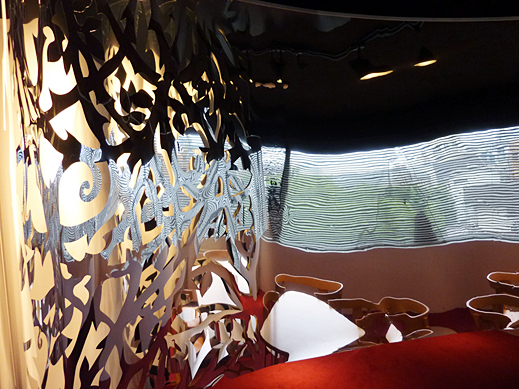 |
| Cutouts in the mylar at certain points reflect the influence of commercial design. |
|
|
A visitor does not just stumble into the Prismic Gallery. It is located on the fifth floor of a nondescript building that backs up to Aoyama Cemetery on the edge of Gaienmae, Tokyo. Small and well lit with windows on two sides, the gallery lends itself to works of an intimate scale. Currently on display is a single installation that fills the space, Gentle Landscape by Hisashi Hojin.
An emerging architect, a graduate of Meiji University and formerly with Jun Aoki's office, Hojin founded his own design atelier, Office Hiyoshizaka, in 2005. His work has been recognized by the Japanese Commercial Environment Designers Association and the Aica Shop Design Award. In 2008 Hojin's interior design for Jin's Global Standard in Hiroshima (one of three shops he designed for the eyewear chain) won the prestigious Good Design Award sponsored by the Japan Industrial Design Promotion Organization. Hojin skillfully employs cutouts and set-design techniques in his retail space-making. He has also found success in houseware design, particularly with his Light Village series. These Monopoly game-like clear acrylic houses are sold as decorative objects or paperweights at such shops as H.H. Style.
In his current installation at the Prismic Gallery, Hojin explores distortions through reflection and transparency. He may be testing an idea for an architectural project on the boards. Two long mylar sheets suspended on edge from the ceiling swirl and spiral about the room, creating spaces within. The reflective material flutters as one walks by. When multiple visitors are experiencing these spaces they generally can see only each other's legs, an intriguing if slightly disturbing phenomenon. With its limited transparency, the mylar allows some visual connections to the space on the other side. At points the material may or may not reflect the bright red carpet of the gallery, the landscape through the window beyond, or the table for six situated in one corner. In a few locations there are delicate cutouts in a flowery pattern that suggests these were influenced by, or created with, a specific retail design in mind.
There are no supporting drawings or information, no content to guide the visitor as to how the designer arrived at his solution. Perhaps expecting such an explanation would spoil the spontaneity. A brief description on Office Hiyoshizaka's homepage roughly translates to: "With the scenery breezing by, new distorted scenes arise. These images mutually reflect each other when a person passes. I aimed for the visitor to have such an experience through my installation in this space."
It seems that the potential of this material inspired the installation. However, the mylar itself has proven ephemeral and is compromising Hojin's statement. In some places it has crinkled, perhaps due to curious visitors touching it, and the result is a stiffening that doesn't allow the material to flow as nicely as it must have right after installation. The choice of venue is perplexing, too. Gentle Landscape is the type of folly that one would be pleased to discover unexpectedly within a public space of appropriate scale. But such a large, all-encompassing installation leaves the otherwise cozy gallery gasping for air.
|